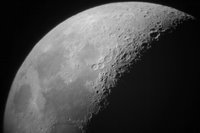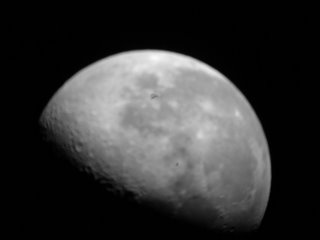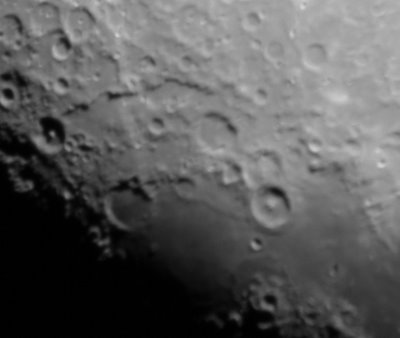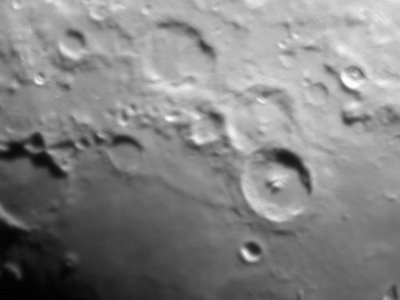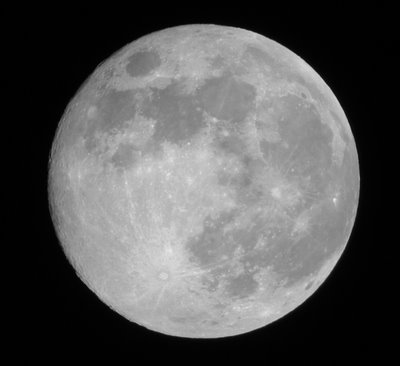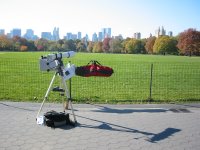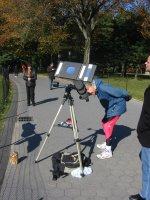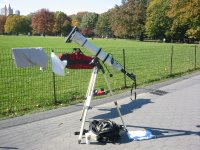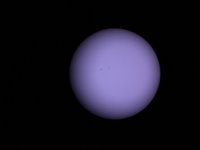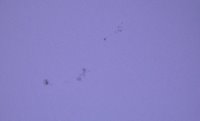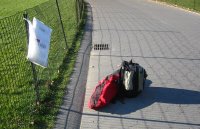I'm impressed by what's well within the reach of the amateur astronomer. Technology is cheap and can be bought as used equipment. A little patience can produce some fine results unheard of ten years ago. The following pictures are not necessarily the crispest but they do show lunar features well. There is a lot to be seen and be drawn to in these photos.
Stratigraphy can be studied from these photos allowing one to sequence lunar events like how the
Imbrium Basin overlaps the
Serenitatis Basin. Investigate how the mare settled into these basins and make educated guesses as to how they formed and which came first.
For this particular cloudy day, I choose to hike in one of my favorite regions on Moon.
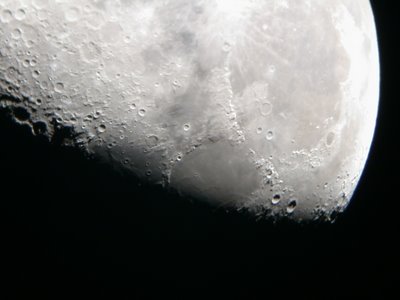
This is the original image with no post processing.
Nikon Coolpix 995; Image Size: 2048x1536; PEG (8-bit) Fine; FL: 26mm; Exp Mode: Programmed Automatic; 1/8 sec - F/4.5; White Bal: Auto; Sharpening: Auto; Noise Reduction: Off
The picture above is an unmarked copy cropped from the larger photo above. Below is the same cropped photo with markup indicating some of the more obvious craters. Compare this with the Lunar Atlas Chart - 78, Theophilus for feature identification (see reference below.)
These photos show the neighborhood surrounding
Cyrillus &
Catharina. In the eyepiece on this evening, these two neighboring craters appeared as a pair of binoculars. The southwestern rim of
Theophilus can be seen superpositioned on the northeastern rim of Cyrillus. In terms of stratigraphy, that makes Theophilus younger than Cyrillus.
Also note that Theophilus's rim is catching light and blocking it from illuminating any points east, whereas Cyrillus' and Catharina's eastern rims rise high enough to catch the setting sunlight. These locations are slightly east of the illuminated Theophilus rim so their elevations must be at least that high. In fact, they are probably highre because of the curvature of Moon. Relative to location west of that, say
Descartes, these rims, excepts their peaks, may fall below the horizon.
Altai Scarp really casts some deep, dark shadows south of Catharina and the arcuate can be followed curving westerly and northerly. Them be cliffs and even in 1/6th the earth's gravty, I wouldn't want to fall from there. Returning to Cyrillus, just east, one watches
Mons Penck cast an obvious blocky shadow to the east, in the same neighborhood, finer black shadow lines interleave with higher ground. Looking northward into the shadowed grounds of
Hypatia, having fallen into night time, we can let ourselves be fascinated with the undulations of light along the terrae before settling for the apparently smooth darker floors of
Mare Tranquillitatis.
Sabine is seen in the lower right corner, it's kissing cousin
Ritter is clipped from this image. Nearby, east of this spot
Statio Tranquillitatis, landing spot for Apollo 11, and three craters named for the first three men to the moon:
Aldrin ,
Collins, and
Armstrong have fallen into the shadow of the moon. Our next opportunity to see will be a waxing crescent of a 6-day moon.
Identifying patterns comes naturally. Whether they are significant or by chance is left to the serious selenographer to study and report. For example,
Abenezra and
Azophi begin a large arc of similar looking craters
Geber,
Almanon,
Abulfeda, and
Andel. If not for noticing this arc I would not have been introduced to them. Now they will serve as landmarks with
Descartes and
Dolland.
I recently read somewhere - forgotten off-hand - someone describe
Sacrobosco as eternally surprised. Like asterisms with patterns of stars, it is easy to make "lunarisms" with the play of light and shadow. Here three obvious craterlets on the floor of Sacrobosco form two widely spaced eyes with an open mouth expressing fascination.
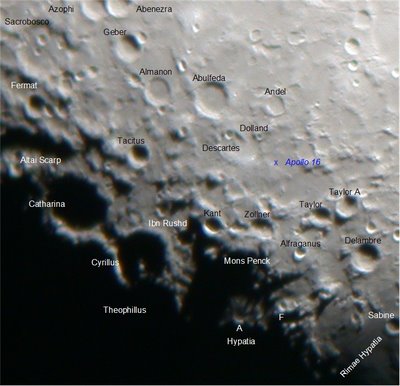 References
References
 Click on image to go to the Lunar Atlas Chart LAC-78, Theophilus at the Lunar and Planetary Institute website.
Click on image to go to the Lunar Atlas Chart LAC-78, Theophilus at the Lunar and Planetary Institute website.
 Image obtained from Wikipedia.
Image obtained from Wikipedia.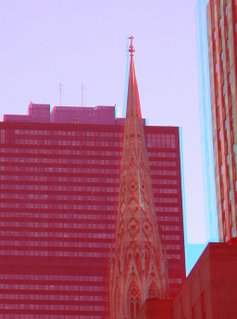 A shot of St. Patrick's Cathedral's spire taken from the middle of West 51st Street. Too wide of steps between shots.
A shot of St. Patrick's Cathedral's spire taken from the middle of West 51st Street. Too wide of steps between shots. Snapshot of Empire State Building from Madison Square Park after downing a Shack Burger & fries.
Snapshot of Empire State Building from Madison Square Park after downing a Shack Burger & fries. Created using material found at Open Tutorial which included links to JPL's Mars Rover images.
Created using material found at Open Tutorial which included links to JPL's Mars Rover images.
